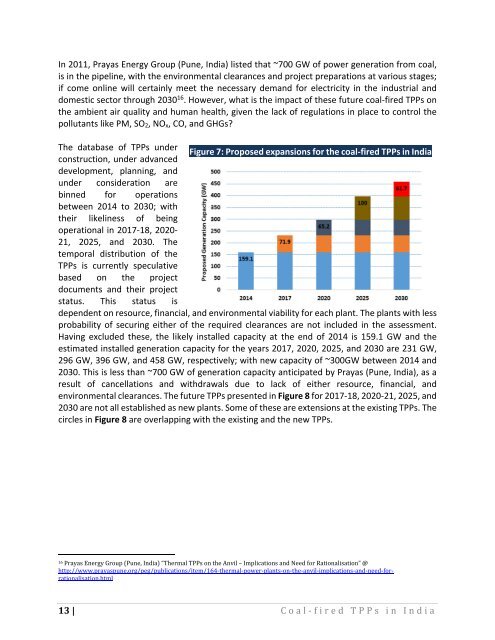Coal Kills
1TndvUf
1TndvUf
Create successful ePaper yourself
Turn your PDF publications into a flip-book with our unique Google optimized e-Paper software.
In 2011, Prayas Energy Group (Pune, India) listed that ~700 GW of power generation from coal,<br />
is in the pipeline, with the environmental clearances and project preparations at various stages;<br />
if come online will certainly meet the necessary demand for electricity in the industrial and<br />
domestic sector through 2030 16 . However, what is the impact of these future coal-fired TPPs on<br />
the ambient air quality and human health, given the lack of regulations in place to control the<br />
pollutants like PM, SO 2 , NO x , CO, and GHGs?<br />
The database of TPPs under<br />
Figure 7: Proposed expansions for the coal-fired TPPs in India<br />
construction, under advanced<br />
development, planning, and<br />
under consideration are<br />
binned for operations<br />
between 2014 to 2030; with<br />
their likeliness of being<br />
operational in 2017-18, 2020-<br />
21, 2025, and 2030. The<br />
temporal distribution of the<br />
TPPs is currently speculative<br />
based on the project<br />
documents and their project<br />
status. This status is<br />
dependent on resource, financial, and environmental viability for each plant. The plants with less<br />
probability of securing either of the required clearances are not included in the assessment.<br />
Having excluded these, the likely installed capacity at the end of 2014 is 159.1 GW and the<br />
estimated installed generation capacity for the years 2017, 2020, 2025, and 2030 are 231 GW,<br />
296 GW, 396 GW, and 458 GW, respectively; with new capacity of ~300GW between 2014 and<br />
2030. This is less than ~700 GW of generation capacity anticipated by Prayas (Pune, India), as a<br />
result of cancellations and withdrawals due to lack of either resource, financial, and<br />
environmental clearances. The future TPPs presented in Figure 8 for 2017-18, 2020-21, 2025, and<br />
2030 are not all established as new plants. Some of these are extensions at the existing TPPs. The<br />
circles in Figure 8 are overlapping with the existing and the new TPPs.<br />
16 Prayas Energy Group (Pune, India) “Thermal TPPs on the Anvil – Implications and Need for Rationalisation” @<br />
http://www.prayaspune.org/peg/publications/item/164-thermal-power-plants-on-the-anvil-implications-and-need-forrationalisation.html<br />
13 | <strong>Coal</strong>-fired TPPs in India




